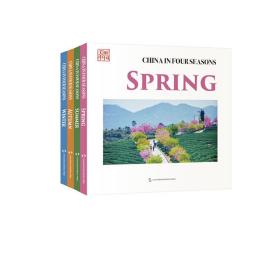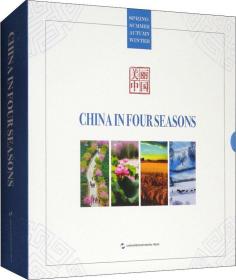
美丽中国(英 套装全4册) [China In Four Seasons]
正版保障 假一赔十 可开发票
¥ 177.85 4.8折 ¥ 368 全新
库存3件
广东广州
认证卖家担保交易快速发货售后保障
作者樊程旭
出版社五洲传播出版社
ISBN9787508540610
出版时间2019-01
装帧平装
开本其他
定价368元
货号27850481
上书时间2024-10-31
- 最新上架
商品详情
- 品相描述:全新
- 商品描述
-
前言
Locating in the east of Asia and on the west coast of Pacific Ocean, China has been a country with vast territory featuring complex land Forms and inhabited by numerous ethnic groups since ancient times. It boasts the world's richest and most beautiful natural and cultural landscape, which can be broken down into Forms oF beauty unique to different regions over the four seasons oF each year. Readers will be able to gain a better understanding oF seasonal changes across the country from south to north, and back again. Topographically speaking, China resembles a giant flower basket. From the eastern and southern coasts of China, with the lowest elevation, to the western highland areas crowed by the vast Qinghai-Tibet Plateau, there are different types of natural landscape such as plains, hills, basins and mountains. Impacted by Factors such as geographical position and climate, such landscapes vary with the changes of season. In special cases, a high mountain range could have landscapes unique to the Four annual seasons existing at the same time on opposite sides. In traditional Chinese aesthetics, spring is the season oF recovery. After the long winter, everything returns to life and begins to grow, becoming full of vitality. Su Dongpo (1037-1101), one of the eight most famous scholars and literati in the Tang and Song Dynasties (618 - 1279), once wrote lyrically in a poem, "Two or three boughs of peach bloom beyond the bamboo grove; when the water in the Spring river becomes warm, ducks are the First to know it." The monotony of Nature in winter is suddenly greeted by gentle spring breezes, colorful flowers bloom. Spring brings new life after a long winter.
导语摘要
中国具有世界上*多样化的地理环境和气候特征,中国人奉行日出而作,日落而息自然规则,人们春种,秋收,夏耕,冬藏,生活在四季轮回中,这样的生活中隐藏着一套严密的自然历法,并沿袭祖先的生活智慧,历经千年而不衰。正是有了辽阔的地理环境才繁衍了57个民族的精彩文化,才有了中国现在的美丽。全套分为《春》《夏》《秋》《冬》4册。Living in the world’s most geographically and climatically diverse country, Chinese people have followed the rules of nature for a long time. They start working when the sun rises and rest when the evening falls. They sow seeds in spring, plow the land in summer, harvest in autumn and preserve food in winter. Behind this way of life, which follows the cycle of the four seasons, lies a set of natural laws extracted from the wisdom of our ancestors and passed down for generations. Never would the nation have nurtured the splendid cultures of its 56 ethnic groups nor its enchantment today without its vast territory.
商品简介
中国具有世界上*多样化的地理环境和气候特征,中国人奉行日出而作,日落而息自然规则,人们春种,秋收,夏耕,冬藏,生活在四季轮回中,这样的生活中隐藏着一套严密的自然历法,并沿袭祖先的生活智慧,历经千年而不衰。正是有了辽阔的地理环境才繁衍了57个民族的精彩文化,才有了中国现在的美丽。全套分为《春》《夏》《秋》《冬》4册。 Living in the world’s most geographically and climatically diverse country, Chinese people have followed the rules of nature for a long time. They start working when the sun rises and rest when the evening falls. They sow seeds in spring, plow the land in summer, harvest in autumn and preserve food in winter. Behind this way of life, which follows the cycle of the four seasons, lies a set of natural laws extracted from the wisdom of our ancestors and passed down for generations. Never would the nation have nurtured the splendid cultures of its 56 ethnic groups nor its enchantment today without its vast territory.
目录
《春生》:PrefaceBeauty Prevailsthroughout Four Seasons
ForewordLuxuriant Sprin
ChaptersWarm SunshineBlooming DayLunar SpringFlowers and Moon
《夏长》:PrefaceBeauty Prevailsthroughout Four Seasons
ForewordGorgeous Summer
ChaptersEarly SummerMidsummerLotus MoonLychees Season
《秋收》《冬藏》
内容摘要
中国具有世界上*多样化的地理环境和气候特征,中国人奉行日出而作,日落而息自然规则,人们春种,秋收,夏耕,冬藏,生活在四季轮回中,这样的生活中隐藏着一套严密的自然历法,并沿袭祖先的生活智慧,历经千年而不衰。正是有了辽阔的地理环境才繁衍了57个民族的精彩文化,才有了中国现在的美丽。全套分为《春》《夏》《秋》《冬》4册。Living in the world’s most geographically and climatically diverse country, Chinese people have followed the rules of nature for a long time. They start working when the sun rises and rest when the evening falls. They sow seeds in spring, plow the land in summer, harvest in autumn and preserve food in winter. Behind this way of life, which follows the cycle of the four seasons, lies a set of natural laws extracted from the wisdom of our ancestors and passed down for generations. Never would the nation have nurtured the splendid cultures of its 56 ethnic groups nor its enchantment today without its vast territory.
精彩内容
Of the 24 solar terms, the “Beginning of Spring” falls on February 2, 3 or 4, and remains officially the start of the season and is closely associated with the moveable Chinese Spring Festival (lunar New Year). Since China has a vast territory and complex terrain, the climate varies from one area to another, accordingly resulting in an earlier or later arrival of Spring. When northern China is still covered by ice and snow, Spring, with all its sense of renewal of life, is already underway on Hainan Island in the far south. Flocks of egrets dance exuberantly in the immense mangrove forests, heralding the arrival of the earliest Spring in China. This gradually spreads from south to north, arriving in the Pearl River basin after crossing the Qiongzhou Strait from Hainan. There is a kind of flower named Mucuna birdwoodiana in Lingnan (a region south of the Five Ridges), known as the messenger of Spring. When it blooms, local people will know Spring has come, and hurry to fully appreciate it for fear of missing the freshness that comes with this annual seasonal opportunity. As a symbol of Spring in southern China, the towering kapok trees are fully covered by gorgeous flowers.
The Ploughing Festival is unique to this region, an occasion when a respected chieftain in each place opens the sluices to channel water into the fields for irrigation. Several days later, the fields are full of water, sparkling in the sun. This marks the formal beginning of the first rice transplanting of the year. Then, the warmer weather of Spring crosses the South Ridge and makes its way to the Yangtze River basin. Meanwhile, large numbers of birds will have begun their migration back from their wintering place. Due to excessive physical exertion involved in flying across the South Ridge, they need to rest and select South Dongting Lake as their habitat in Yiyang, Hunan. In the early Spring, willows dance in the refreshing breeze watched over by the undulating mountains in the distance. The most charming part of this season in the history of Chinese culture emerges at the West Lake in Hangzhou and nearby Suzhou with its misty rain. After the Spring Equinox (March 20 or 21), tea plants on Dongting Mountain southeast of Taihu Lake begin to sprout, awakening from their winter hibernation. Following the latitudinal change from the low to the high, Spring continues to spread northward after crossing the Qinling Mountains and the Huaihe River. The Qinghai-Tibet Plateau is also not immune to this revival. Although it gives an impression of being cold, oxygen-deficient and desolate, Nature endows it with luxuriant wild plants, such as a sea of peach blossoms covering the mountains reaching towards the river valley in Nyingchi. In April, Spring quietly comes to the diversiform-leaved poplar woods along the Tarim River in southern Xinjiang. The air has been full of the light fragrance of narrow-leaved oleaster flowers, but it still takes over one month for the flowers to come into full bloom. Girls like to pick a spray of the flowers and place them in a vase, thus bringing Spring right into their houses. People in the Central Plains enjoy Spring from April, when peonies are in full bloom in Luoyang and Heze. In particular, the Peony Flower Fair displays hundreds of thousands of the peonies, in colors ranging from purple red to white or yellow, around the Qingming Festival [Tomb Sweeping Day, marking the start of the fifth solar term in the traditional calendar] attracting numerous visitors. However, the most exciting spring scene in northern China is the Peach Blossom Flood at Hukou on the Yellow River. This is a time when the ice in the upper reaches of the Yellow River melts, greatly increasing the amount of water tumbling down Hukou Fall. Mohe is at the northernmost end of China. After a long winter, Spring arrives there in May. Then, azaleas are in full bloom covering all the mountain slopes. Yet, it still snows at times there even in Spring. In southern China, people go over the snow in search of plums, but in Mohe, people appreciate azaleas amid the snow. With the advent of Spring throughout China, everything comes back to life, showing the eternal vitality of Nature. Thus, we should cherish spring-time and set sail amid delightful breezes.
相关推荐
— 没有更多了 —
![美丽中国(英 套装全4册) [China In Four Seasons]](https://www0.kfzimg.com/sw/kfz-cos/kfzimg/acdecbba/c33ff614c2a6d419_b.jpg)










![美丽中国(英 套装全4册) [China In Four Seasons]](/dist/img/error.jpg)










以下为对购买帮助不大的评价